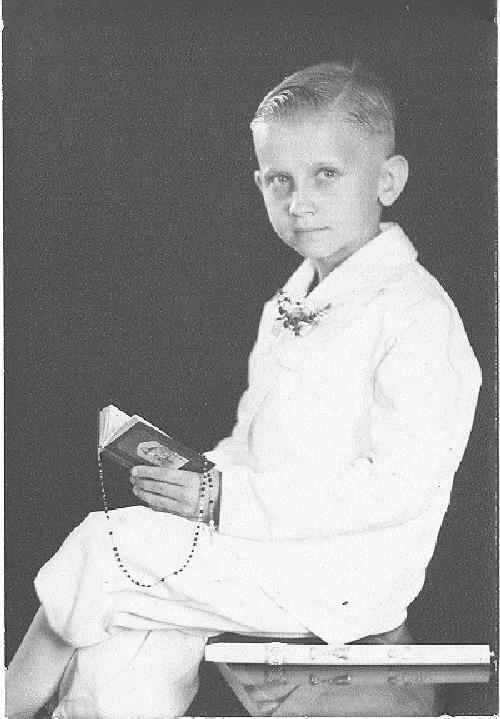
Figure 1.-.This American boy wears a white knickers suit for his First Communion. Its a bit difficult to make out the coat style. The portrait is undated, but we believe was taken about 1930. |

|
Looking at First Communion suits over time are a good indicator of popular boys' fashions over time. I'm not sure what Catholic boys wore in the early and mid-19th Century, but by the late-19th Century those families that could afford it dressed their sons in smart new suits. Boys wore a variety of suits, mostly knee pants single and double breasted suits. Some boys wore sailor suits, but this was not as common as in Europe. Styles for younger boys such as Fauntleroy suits were not normally worn, even though some older boys did wear Fauntleroy suits. After World War I (1914-18) styles changed with boys wearing mostly knicker suits through the 1930s, but usually long pants suits since the 1940s. Some boys wore short pants suits, but they were less common. This continued through the 1950s, but the trend since has been more to a less formal outfit, a white shirt, tie, and slacks.
First communion suits were primarily made up a jacket and matching trousers. A few suits had vests (waistcots). Rarely do we see headwear as males had to remove their headwear in church. We note a variety of shirts and neckwrear worn ewith the suyits. Hosiery varied over time, but generally matched the suit. as fashions changed over time as did footwerar..
Looking at First Communion suits over time are a good indicator of popular boys' fashions over time. I'm not sure what Catholic boys wore in the early and mid-19th Century, but by the late-19th Century those families that could afford it dressed their sons in smart new suits. Boys wore a variety of suits, single and double breasted suits. We see some Norfolk suits, but generally more formal styles were worn. Some boys wore sailor suits, but this was not as common as in Europe. Styles for younger boys such as Fauntleroy suits were not normally worn, even though some older boys did wear Fauntleroy suits. We see some boys wearing Eton styles after World War I (1914-18). The trend in more recent years have been more to a less formal outfit, a white shirt, tie, and slacks.
We do not have much information on the 19th century. First Communion celebrations were not as common during the 19th century, in part because there were fewer Catholics. We see some knee pants in the very early 20th century, but knickers seem much more popular. Most First Communion suits were knicker suits in the 1910s. After World War I (1914-18) we see both knicker and short pants suits. Some parents thought short pants were more suitable for the younger boys soing First Communion. Knickers declined in popularity during the 1930s, but short pants suits were quite common. Beginning in the 1950s we see more boys beginning to wear long pants suits. Boys still wore short pants suits into the 1960s, but they were less common. Actually long pants sxuits were not very common either becsuse many parents and schools took a more casual approach. The trend in more recent years has been more to a less formal outfit, a white shirt, tie, and slacks.
First Communion suits were done in a variety oc colors. This is of course dificult to assess in period black-and-white photography. This is a little easier for First Communion suits than other period suits bedcause so many were dark or white suits. We think the dark suits were mostly navy blue rather than black in the 1900s and 10s. We are less sure about the 1920s and 30s. We begin to see white suits in the 1920s, but we continue to see the dark suits as well. The advantage of the dark suits is that they could be worn for ,many other occassions as well after the First Communion. White suits had fewer usees after the First Communion celebration. The white suits were done primarily as short pants suits, but we see somre knicker and long pants suits as well. Some parents bought a variety of other colored suits thinking more about usage after First Communion.
Navigate the Historic Boys' First Communion pages:
[Return to the Main U.S. First Communion garments]
[Return to the Main U.S. First Communion page]
[Return to the Main First Communion page]
[Renewals]
[Argentina]
[Belgium]
[Canada]
[England]
[France]
[Germany]
[Ireland]
[Mexico]
[Spain]
[Switzerland]
Navigate the Historic Boys' Clothing Web Site:
[Introduction]
[Activities]
[Biographies]
[Chronology]
[Clothing styles]
[Countries]
[Bibliographies]
[Contributions]
[Essays]
[FAQs]
[Glossaries]
[Images]
[Links]
[Registration]
[Tools]
[Boys' Clothing Home]
Navigate the Historic Boys' Clothing Web chronological pages:
[The 1920s]
[The 1930s]
[The 1940s]
[The 1950s]
[The 1960s]
[The 1970s]
Navigate the Historic Boys' Clothing Web style pages:
[Short pants suits]
[Blazers]
[Jackets]
[Kilts]
[Sailor suits]
[Sailor hats]
[Ring bearer/page costumes]
[Shortalls]
